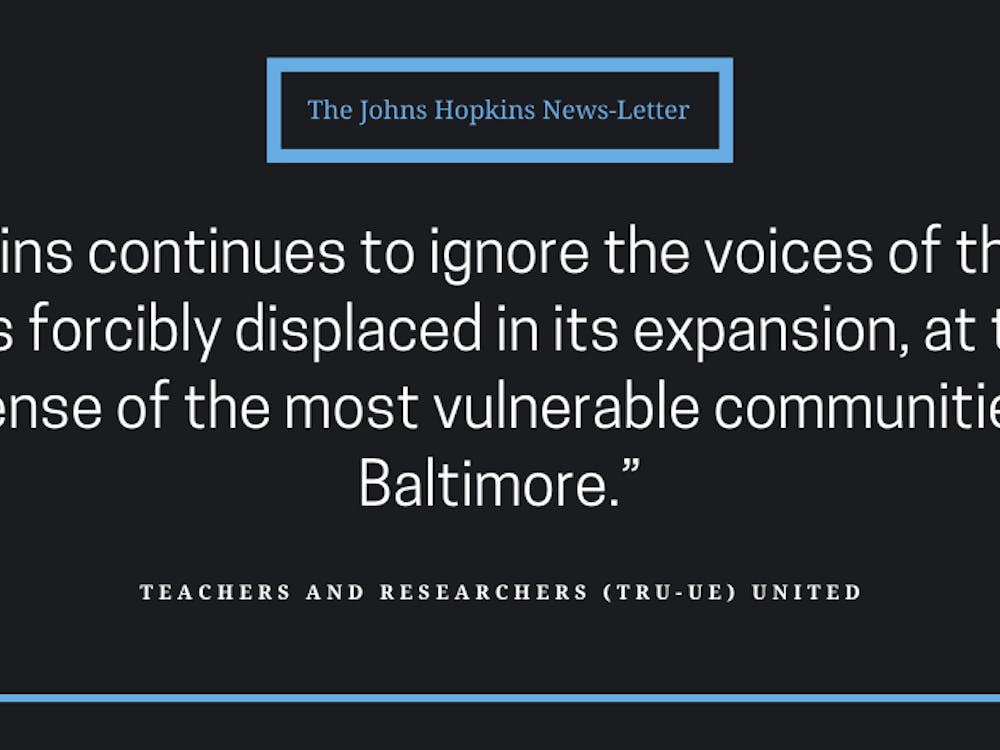Roland Park, a wealthy, predominantly white neighborhood directly north of campus, carries a legacy of racial discrimination. The Roland Park Company, a Baltimore suburban developer, planned the neighborhood with the goal of denying black people the right to buy homes there.
The Sheridan Libraries, which holds the Company’s records, hosted a panel on Oct. 27 that explored the current state of discriminatory housing in Baltimore.
Panelists at the event included Paige Glotzer, a Hopkins Ph.D. graduate and historian; Matt Hill, an attorney and leader of the Human Right to Housing Project at the Public Justice Center; and Lawrence Jackson, a Bloomberg Distinguished Professor of English and History.
Glotzer began by explaining how the Roland Park Company’s policies contributed to exclusion and racial segregation in Baltimore.

Specifically, she discussed redlining, a practice where white lawmakers and capitalists excluded poor, black residents from Baltimore’s wealthy white neighborhoods, like Roland Park.
Additionally, she outlined how property deeds from the Company explicitly denied black people the right to live in its developments.
“[The deeds] read, ‘At no time shall land included and... any building erected thereon be occupied by any Negro or person of Negro extraction,’” Glotzer said.
She then went on to explain how the Company used physical boundaries to perpetuate segregation. She highlighted the wall built around the Guilford neighborhood.
“While walking down York Road, you straight up hit a wall, the Guilford Wall. When I was looking at the archives, some of the conversations in the [Company’s] office around this wall actually had to do with exclusion,” she said.
Glotzer realized that the deliberately racist strategy of the Roland Park Company still has repercussions today.
“One of the things that I noticed quickly when I moved to Baltimore and started walking around Greenmount Avenue and York Road was the set of boundaries that the company very deliberately put in place to create a segregated space,” she said. “Not just for racial reasons, but so that the company could control that area and keep it ‘safe, healthy and homogenous.”
She then moved on to discuss how residential zoning was used to discriminate against black people.
In 1910, Baltimore passed into law an ordinance that stated that it was illegal for any person of color to move into a house on a block that was more than 50 percent white. It was the first instance of racism in the city gaining legal support and backing.
Panelists made the point that these practices of the past have a tremendous impact on Baltimore’s current state.
Matt Hill spoke about how historical patterns in housing caused a great wealth disparity among modern day Americans.
“White Americans were able to pay down their mortgages, to build equity, to pay down principal and get price appreciation,” Hill said. “Experts believe this is one of the main reasons why African Americans today have about an average of six percent of the wealth of many white Americans.”
Hill is currently campaigning to start a project called United for Homes. This project focuses on building more affordable housing using the money in Baltimore’s general obligation bonds.
Hill argued that the government has the money to pay for the project. However, it lacks the political motivation to change the current situation of low-income Americans.
He pointed to the way some people brush off the complex problem of wealth disparity as a cultural problem.
“Today we wring our hands as a society and we say these problems are so huge and what can we possibly do. It’s such a massive issue, and it’s all true. Unfortunately, some folks then say that if people just pulled up their pants, stopped listening to rap music, pulled themselves up by their bootstraps, then that would be the solution,” Hill said.
He emphasized that the solution is not just an easy fix and is rather ingrained within society.
“It’s a cultural problem... a government by and for white people that created this problem and this modern apartheid state,” he said.
The resounding theme of the evening was that in order to understand the current segregation problem in Baltimore, it is important to look back at history.
Colette Shade, who is writing a book set in Roland Park, echoed that sentiment.
“Much of the race and class stratification that you see in Baltimore today is the cumulative result of things like the creation of ‘exclusive’ neighborhoods in the early 20th century, federal economic policies in the late 20th century and, before that, the legacy of slavery in the state of Maryland,” Shade wrote in an email to The News-Letter.
Shade emphasized that the policies enforced by American leaders throughout history can help people understand exclusion today.
“Understanding history helps us to understand that conditions in contemporary Baltimore are not inevitable and were instead forged through a series of policy choices,” Shade wrote.
The panel was followed by a question and answer session, where the speakers spoke about the University’s role in perpetuating racial segregation in Baltimore.
Glotzer pointed out the University’s role in adding to segregation in Baltimore.
“Hopkins has been one of the drivers of racially motivated displacement in East Baltimore. Hopkins is trying to incentivize entirely new populations into new developments in East Baltimore,” Glotzer said. “Eager Park, they’re rebranding the area, giving it new names. They’ve long owned a lot of the property that they’ve sat on for many years, developing it when they get the profit margins right.”
Glotzer went into detail about how the University’s policies involving affordable housing fall short in the end.
“Hopkins talks about the affordable housing it might create or the ways that they’re allowing people to purchase homes in the areas they were just replaced from,” she said. “Really, they come up short and inadequate and perpetuate the racial displacement in East Baltimore.”
Senior Chelsea Zou shared her thoughts on the panel and the issue of racial displacement. She explained that she hopes more students will come to thought-provoking events such as this one, and that students would be more aware of these issues.
“I do wish that Hopkins would do a better job of publicizing when events like this are happening on campus,” she said.
She said that the panel has affected her perception of Baltimore, citing the unique perspective of the panel.
“Segregation in Baltimore is a major issue, and I liked how the panel looked at segregation through historical, legislative and social lenses,” she said. “Attending a panel like this really makes you realize that segregation is literally happening in our neighborhood of Charles Village and the neighborhoods surrounding us, like Roland Park and Guilford.”






















Please note All comments are eligible for publication in The News-Letter.